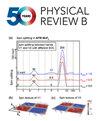Transition between light-induced attraction and repulsion of nanoparticles on a lithium niobate surface
IF 3.7
2区 物理与天体物理
Q1 Physics and Astronomy
引用次数: 0
Abstract
Recent investigations have revealed a new phenomenon involving the transfer of charges between metallic as well as dielectric particles and the surfaces of photovoltaic crystals under illumination. Given its potential relevance to microfluidic and nanotrapping applications, understanding and controlling this phenomenon is of considerable interest. In this study, we examine the potential for manipulation of this charge transfer by customizing the induced electric field in terms of its strength and shape. In addition, we explore a method to mitigate this charging effect by introducing a thin layer between the crystal and the particle suspension. Specifically, we investigate the controlled trapping and repulsion of metallic micro-objects and nano-objects using a slowly increasing electric field induced by light in an iron-doped lithium niobate crystal. By employing structured light patterns with modulated amplitudes, we analyze the influence of shape and exposure of the light patterns on the dynamic movement of the particles. Our observations reveal two distinct regimes characterized by an initial attraction followed by repulsion. We present a model based on an electrical resistor-capacitor circuit that explains these two regimes and provides a good estimate of the temporal transition between them. These findings contribute to the advancement of controlled optoelectronic manipulation techniques for particles that utilize ferroelectric crystals.纳米粒子在铌酸锂表面的光诱导吸引和排斥之间的转变
最近的研究揭示了一种新的现象,涉及在照明下金属和介电粒子与光伏晶体表面之间的电荷转移。鉴于其与微流体和纳米捕获应用的潜在相关性,理解和控制这一现象是相当有趣的。在这项研究中,我们研究了通过定制感应电场的强度和形状来操纵这种电荷转移的潜力。此外,我们探索了一种通过在晶体和颗粒悬浮液之间引入薄层来减轻这种充电效应的方法。具体来说,我们研究了在掺铁铌酸锂晶体中,利用光诱导的缓慢增加的电场来控制金属微物体和纳米物体的捕获和排斥。通过调制振幅的结构光模式,我们分析了光模式的形状和曝光对粒子动态运动的影响。我们的观察揭示了两种截然不同的机制,其特征是最初的吸引随后是排斥。我们提出了一个基于电阻-电容电路的模型,该模型解释了这两种状态,并提供了对它们之间时间过渡的良好估计。这些发现有助于利用铁电晶体的粒子控制光电操纵技术的进步。2025年由美国物理学会出版
本文章由计算机程序翻译,如有差异,请以英文原文为准。
求助全文
约1分钟内获得全文
求助全文
来源期刊

Physical Review B
物理-物理:凝聚态物理
CiteScore
6.70
自引率
32.40%
发文量
0
审稿时长
3.0 months
期刊介绍:
Physical Review B (PRB) is the world’s largest dedicated physics journal, publishing approximately 100 new, high-quality papers each week. The most highly cited journal in condensed matter physics, PRB provides outstanding depth and breadth of coverage, combined with unrivaled context and background for ongoing research by scientists worldwide.
PRB covers the full range of condensed matter, materials physics, and related subfields, including:
-Structure and phase transitions
-Ferroelectrics and multiferroics
-Disordered systems and alloys
-Magnetism
-Superconductivity
-Electronic structure, photonics, and metamaterials
-Semiconductors and mesoscopic systems
-Surfaces, nanoscience, and two-dimensional materials
-Topological states of matter
 求助内容:
求助内容: 应助结果提醒方式:
应助结果提醒方式:


